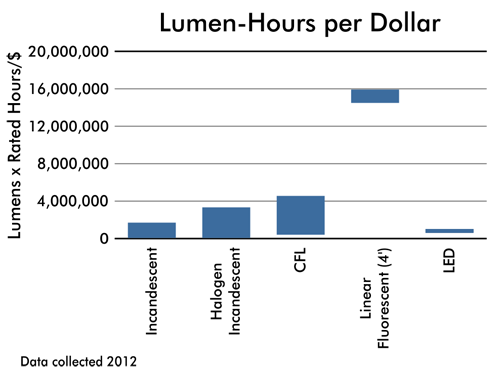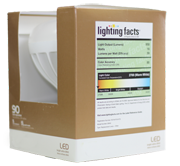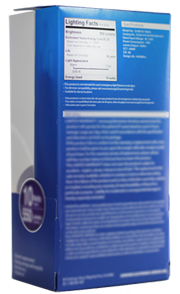
How to Select Bulbs and Fixtures
Reading Product Packaging
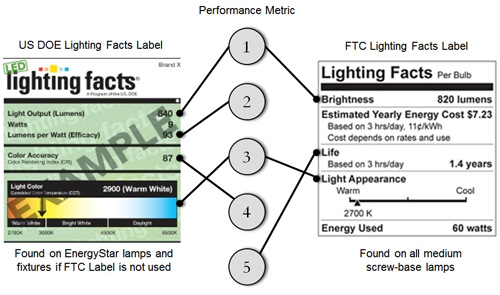
Lighting products include the following performance metrics on packaging:
- Light output
- Efficacy
- Correlated color temperature
- Color rendering
- Life
Consider these and other qualities described below when selecting your lighting.
Light Output
The amount of light that is produced by a bulb, or its light output, is measured in lumens. (The technical term for the amount of light produced is "luminous flux," which is the time rate of flow of light.) The measure of lumens takes into account how much energy the light source produces at each wavelength and how sensitive the eye is to energy at that wavelength. The following table displays the lumens produced by standard incandescent bulbs.
| Lumens Produced By Standard Incandescent Bulbs | |
|---|---|
| Incandescent Bulb Power (Watts) |
Light Output (Lumens) |
| 25 | 250 |
| 40 | 450 |
| 60 | 800 |
| 75 | 1100 |
| 100 | 1600 |
The U.S. Federal Trade Commission (FTC) requires that all screw-in bulbs show the light produced in lumens on the package.
Power Demand
Lighting accounts for an average of 13 percent of the electricity consumed in homes, so buying more energy efficient lighting products will have an effect on your electric bill.
The power that is used to create light in the home is measured in a unit called the watt, abbreviated as "W," which the FTC requires to be marked on the packaging of all screw-in bulbs. Most integrated LED fixtures will also indicate the power demand, in watts, on the package. Linear fluorescent lamps have a rated power demand, but because their actual power demand is affected by the ballast in the fixture, the power needs to be measured or determined from the ballast product literature.
One thousand watts equals one kilowatt (kW). Utility companies bill residential customers for the number of kilowatt-hours (kWh) they use. For example, ten 100-watt bulbs operated for 1 hour would use 1 kWh of energy (10 bulbs x 100 watts x 1 hour = 1 kWh). Thus energy used for lighting can be saved either by reducing the power required for lighting or by reducing the time that the lighting is used.
Efficacy
The efficacy of a bulb is the ratio of lumens produced to watts used. This lumen-per-watt (LPW) ratio is similar to the miles-per-gallon ratio used for automobiles, in that a higher ratio indicates a more efficacious bulb. The lumen-per-watt ratio is an important factor for selecting a bulb.
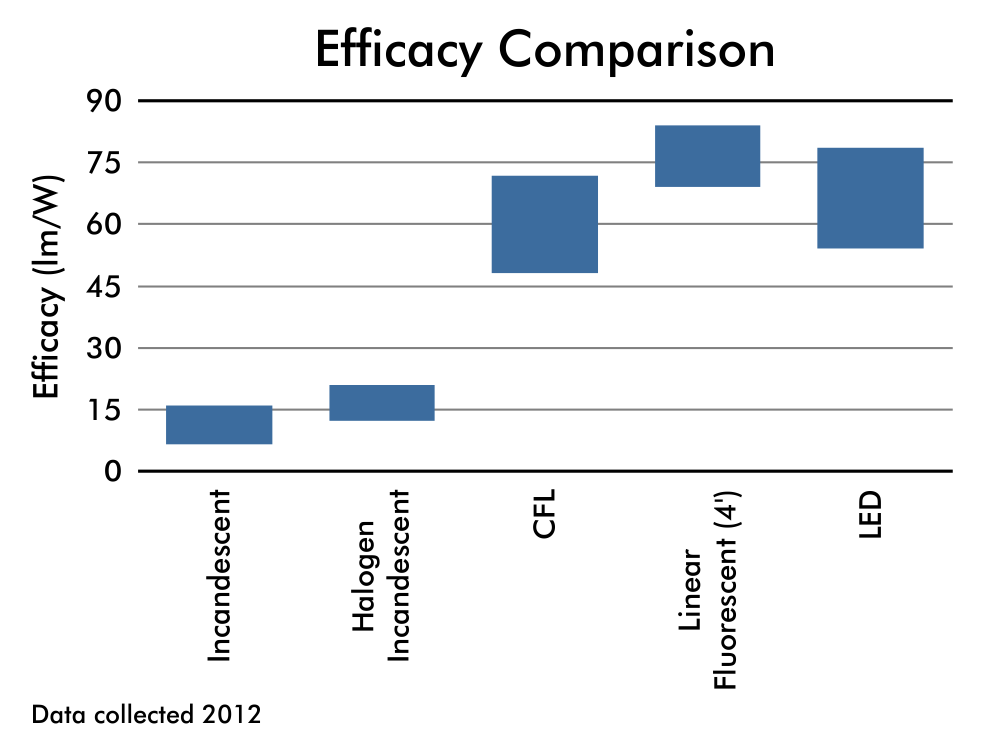
Efficacy is used to rate bulbs; efficiency is the measure used for fixtures. Efficiency expresses the light output from a fixture as a percentage of the light output from the bulbs. For example, if a fixture contains one fluorescent bulb that emits 1000 lumens, and the fixture in turn emits 900 lumens, then the fixture has an efficiency of 90 percent. Choose fixtures with high efficiencies to make the best use of energy. However, lower efficiency fixtures may provide better glare control.
Bulb efficacy and fixture efficiency may not be listed on product packaging. However, if the product is ENERGY STAR® qualified, then it will have a high efficacy (in the top 25% of related products).
Power Quality
Fluorescent and LED products use electronic ballasts or drivers to operate. These ballasts can affect the power quality in a home. Power quality refers to the characteristics of the current and voltage supplied to electrical equipment. Poor power quality can cause inefficient operation of the utility company's equipment and may also interfere with other electrical equipment in the home.
Power quality is not labeled on product packaging. Typically, commercial grade products have higher power quality than residential grade products.
Power factor is a measure of how closely the voltage and current phases of AC power are aligned. Some utilities require commercial and industrial customers to maintain their total power factor within a certain range. For this reason, commercial grade lighting products may have a power factor closer to unity (perfect voltage-current-phase alignment) than residential grade products.
Electromagnetic Interference
Electromagnetic emissions from electronic devices, including electronic ballasts and drivers used for fluorescent and LED lighting products, can cause interference with reception of electromagnetic signals by other devices (radio, TV, etc.) The U.S. Federal Communications Commission (FCC) sets emissions limits on bulbs and fixtures. Compliance is mandatory for all products sold in the U.S., so it is not marked on packaging. The requirements for residential grade products is stricter than those for commercial grade products. However, even the residential emission requirements may not prevent interference within a single residence (rather, the intent is to prevent interference with a neighbor's electronics).
Illuminance
When the light emitted by a bulb falls on a surface, it is best referred to as illuminance, although it is sometimes called light level. Illuminance is measured in units called footcandles (lumens per square foot) or lux (lumens per square meter). Generally, casual activities require approximately 5 footcandles; more visually demanding activities such as preparing food or reading require approximately 20 to 50 footcandles. The recommended illuminances vary based on the age of the person performing the work, the size and contrast of the task materials, and the speed and accuracy with which the work must be performed. The designs should provide enough light for the tasks that typically are conducted in each room. If more precision is required when designing a lighting system, consult the Illuminating Engineering Society of North America's Lighting Handbook.
Distribution
Another characteristic of light that is helpful to understand is distribution, the intensity of the light that is emitted in each direction. For example, think of the beam of light emitted by an automobile headlight. The fixture directs most of the light forward, in a narrow beam. This light distribution pattern differs from that created by the small fixture inside the automobile, above the passengers. Inside, the fixture has a very diffuse and broad light distribution pattern. Choose technologies that distribute light to the area where it is most needed. If light is distributed to an area where it is not needed, it is wasted and the design is not efficient.
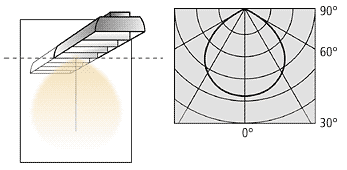
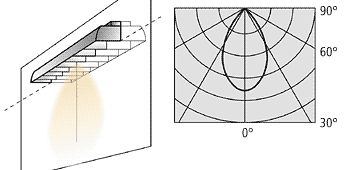
As shown in these candlepower distribution curves, this fixture distributes light more widely in one direction than the other.
Color Rendering
The color rendering index (CRI) measures the effect of light on the perceived color of objects. To determine the color rendering index, the color appearances of eight standard color chips are measured under a reference light source with the same correlated color temperature as the bulb being evaluated. Then the eight color chips are measured under the bulb being evaluated. If these colors are exactly like those measured under the reference source, the rated color rendering index for the bulb is 100. If the measured color of the eight standard chips shifts from the reference condition, the color rendering index is less than 100. A low color rendering index indicates that some colors may appear unnatural when illuminated by the bulb.
Incandescent bulbs, including halogen, render color like the reference source does so they typically have color rendering indices of 95 to 100. Some cool white fluorescent bulbs have a relatively low color rendering index (such as in the 60s or 70s). Premium fluorescent bulbs and most CFLs are available with color rendering indexes of 80 and above.
CRI is not marked on all lighting product packages. All products with the ENERGY STAR® label meet a minimum CRI requirement. Some LED products may list the CRI as "Color Accuracy" on the package.
CRI is a measure of color rendition accuracy. Other factors, such as saturation, affect how pleasing colors are and how well they can be differentiated.
Correlated Color Temperature
Correlated color temperature (CCT) describes the color appearance of the light in terms of its perceived warmth or coolness. If "pure white" is considered to be neutral, then a "yellow white" is warm and a "blue white" is cool. Correlated color temperature is measured on the Kelvin scale. A low correlated color temperature, less than 3100 K, identifies a warm white light, such as that emitted by an incandescent bulb. A high correlated color temperature, more than 4000 K, identifies a cool white light, such as that produced by an overcast sky.
All screw-in bulbs are required to include the CCT on the package, where it is labeled "light appearance" or "light color."
Life
Bulb life is most relevant when a light bulb is installed in a difficult-to-reach location. For most applications, bulb life should be considered in conjunction with price, power demand, and light output to determine which light source will provide energy and cost savings. For incandescent (including halogen) and fluorescent light sources, the life of a bulb is defined as the length of time it takes for half of a large group of the same bulbs to burn out. Because it is a median value, it is possible for some bulbs to last much more or less time than the rated life. LEDs, in contrast, tend to fail by growing too dim rather than burning out. Therefore, the life of LED products, is based on the average time it takes for a large group of those products to dim to 70% of their initial light output. Consult the following chart for a general comparison of light sources based on life, price, and light output. The greater the lumen-hours per dollar, the better.
